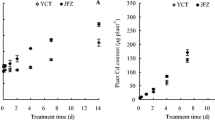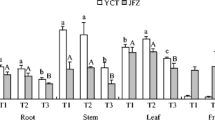Abstract
Capsaicin and dihydrocapsaicin contribute to pungency as well as having health-promoting properties, in peppers. Twenty-three genotypes (four spp.) of hot pepper from the USDA germplasm collection were grown in the field to identify accessions having increased concentrations of these two compounds and determine the concentrations of heavy metals, in mature fruits. Concentrations and relative proportions of capsaicin, dihydrocapsaicin, and seven heavy metals varied between and within pepper species. Plant Introduction 547069 (C. annuum) contained the greatest concentrations of the two pungent compounds. Fruits of PI-439381 and PI-267729 (C. baccatum) accumulated the greatest concentrations of Pb, while PI-246331 (C. annuum) accumulated the greatest concentration of Cd among accessions tested.

Similar content being viewed by others
References
Agency for Toxic Substances and Disease Registry (2004) Toxicological profile information sheet. http://www.atsdr.cdc.gov/toxprofiles/
Antonious GF, Jarret RL (2006) Screening Capsicum accessions for capsaicinoids content. J Environ Sci Health, Part-B 41:717–729
Antonious GF, Snyder JC (2007) Accumulation of heavy metals in plants and potential phytoremediation of lead by potato, Solanum tuberosum L. J Environ Sci Health, Part-A 42:811–816
Antonious GF, Kochhar TS, Jarret RL, Snyder JC (2006) Antioxidants in hot pepper: variation among accessions. J Environ Sci Health B41:1237–1243. doi:10.1080/03601230600857114
Cavett V, Waninger EM, Krutak JJ (2004) Visualization and LC/MS analysis of colorless pepper sprays. J Forensic Sci 49:1–8. doi:10.1520/JFS2003215
Codex Alimentarius Commission (2006) Joint FAO/WHO food standards, The Hague, Netherlands ftp://ftp.fao.org/codex/ccfac38/fa38_19e.pdf
Commission of the European Community (2002) Commission Regulation No. 221/2002 of setting maximum levels for certain contaminants in foodstuffs. Official Journal of the European Communities, Brussels, February 6, 2002
Demirezen D, Aksoy A (2006) Heavy metal levels in vegetables in Turkey are within safe limits for Cu, Zn, Ni, and exceeded for Cd and Pb. J Food Qual 29:252–265. doi:10.1111/j.1745-4557.2006.00072.x
Institute of Medicine (2003) Dietary reference intakes: applications in dietary planning, p 248. The National Academies Press, Washington, DC
Melo WJ, Aguiar P, Melo GM, Melo VP (2007) Nickel in a tropical soil treated with sewage sludge and cropped with maize in a long-term field study. Soil Biol Biochem 39:1341–1347. doi:10.1016/j.soilbio.2006.12.010
Morrison G, Fatoki OS, Linder S, Lundehn C (2004) Determination of heavy metal concentrations and metal fingerprinting of sewage sludge. Water, Air, and Soil Poll 152:111–127. doi:10.1023/B:WATE.0000015353.16815.b9
Ohnessorge FK, Wilhelm M (1991) Zinc. In: Merian E (ed) Metals and their compounds in the environment: occurrence, analysis and biological relevance. VCH Weinheim, New York, Base, Cambridge, p 1330
Padilla MC, Yahia EM (1998) Changes in capsacinoids during development, maturation, and senescence of chilie peppers and relation with peroxidase activity. J Agric Food Chem 46:2075–2079. doi:10.1021/jf970972z
Sicuteri F, Fanciullacci M, Nicolodi M, Geppetti P, Fusco BM, Marabini M, Alessandri M, Campagnolo V (1990) Substance P theory: a unique focus on the painful and painless phenomena of cluster headache. Headache 30:69–70. doi:10.1111/j.1526-4610.1990.hed3002069.x
Surh YJ, Seoul SK (2002) Antitumor promoting potential of selected spice ingredients with oxidative and antiinflammatory activities. Food Chem Toxicol 40:1091–1097. doi:10.1016/S0278-6915(02)00037-6
Thuy HTT, Vy NNH, Loan TTC (2007) Anthropogenic input of selected heavy metals (Cu, Cr, Pb, Zn, and Cd) in the aquatic sediments of Hochiminh City, Vietnam. Water, Air and Soil Poll 182:73–81. doi:10.1007/s11270-006-9321-9
Van der Sluis AA, Dekker M, Skrede G, Jongen WM (2002) Activity and concentration of polyphenolic antioxidants in apple juice. J Agric Food Chem 50:7211–7219. doi:10.1021/jf020115h
Acknowledgments
We thank John Snyder for his assistance in ICP analysis and Robert Jarret for providing hot pepper seeds. This investigation was supported by a grant from USDA/CSREES to Kentucky State University under agreement No. KYX-2004-15102.
Author information
Authors and Affiliations
Corresponding author
Rights and permissions
About this article
Cite this article
Antonious, G.F., Kochhar, T.S. Mobility of Heavy Metals from Soil into Hot Pepper Fruits: A Field Study. Bull Environ Contam Toxicol 82, 59–63 (2009). https://doi.org/10.1007/s00128-008-9512-8
Received:
Accepted:
Published:
Issue Date:
DOI: https://doi.org/10.1007/s00128-008-9512-8




